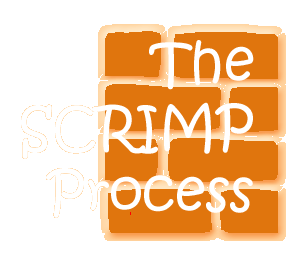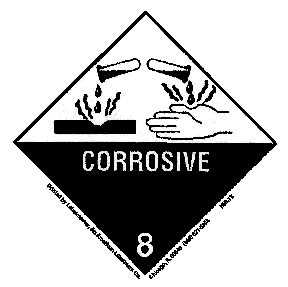

I know, I know. You're sitting there wondering what a SCRIMP is. Well, it's not the Southern pronunciation of shrimp. In fact, it's an acronym which stands for Seemann Composites Resin Infusion Molding Process. It's a new process used in the production of composite materials.
Click here to see some things made with SCRIMP.

 Look at this label from
something corrosive. The guy's finger is melting off for goodness sake! And look next to his hand. He spilled some on the table. You wouldn't want to do that to your mom's dining room table, now would you kids? No you wouldn't. This has been a public safety message from the CCC, the Canadian Corrosives Council.
Besides that, it can get expensive, but you can read about it anyway.
Look at this label from
something corrosive. The guy's finger is melting off for goodness sake! And look next to his hand. He spilled some on the table. You wouldn't want to do that to your mom's dining room table, now would you kids? No you wouldn't. This has been a public safety message from the CCC, the Canadian Corrosives Council.
Besides that, it can get expensive, but you can read about it anyway.
Making a composite with the SCRIMP process is a lot like making a cake. You mix a bunch of things together, pour it into a pan, stick it in the oven, and a few hours later, VOILA, composite cake! Here's the recipe.
First, you need your pan. To solve this problem, go ahead and build yourself a real big mold. How big? REAL big! With SCRIMP you can mold real big parts (like an entire ship hull weighing up to 3000 pounds!) at one time! Amazing, huh? Anyway, build this mold and make it look like you want the outside of the composite to look. Don't worry about making a top mold though, because SCRIMP doesn't need it.
Next, "grease" your mold with something like polytetrafluoroethylene so your composite doesn't stick to the mold like a cake sticks to a pan if you don't grease it.
Now, put a layer of fiber down all over the inside of your mold. This fiber is what gives the composite most of its strength. This fiber is often fiberglass, nylon, or even carbon fiber.
Next, if you want your composite to be thick yet still light, you should put in a core. This core could be any substance like foam or even balsa wood.
Next, you should put down another layer of fiber, and stick it all up there with some medium .
Finally, put a plastic bag over the top and seal the side around the mold. Now, hook up a vacuum pump to the bag and suck all the air out of the mold. There, now the pan is prepared. On to the batter.
The batter of our composite cake is called the matrix resin. The flour of the matrix is the epoxy resin and our eggs are called the curing agent. There are a whole bunch of different epoxy resins and even more different kinds of curing agents. They all affect the way your cake turns out in different ways. So choose wisely, or else your cake will be a flop. Now mix your eggs and flour, I mean your resin and curing agent, together and put in a big barrel and connect it with a hose to the bag. The vacuum will suck the resin into the mold and through the fiber until the whole mold is filled. Just like pouring batter into a pan.
Now, put the cake in the oven 4-6 hours at 350 degrees. Of course your oven has to be real big to fit your real big mold in. So your mom's oven in the kitchen probably won't work. In fact, the oven you need wouldn't even fit in the kitchen, it would have to be as big as a house. I hope it's self cleaning.
And when the timer goes "ding", your composite cake is done. Just pull off the bag, and pop it out of the mold. Now, put it on a nice plate and ice it. Don't devalue the importance of icing. Icing is an important choice to make when making a composite cake. The wrong icing can destroy a good cake while a good icing can make the worst composite look really good. Chocolate and strawberry are two of my favorite, but be creative. However, never use an icing made with real whipped topping. It may look real pretty, but it obliterates the flavor of a good composite cake.
Now just decorate, put on the candles, sing that birthday song (you know the drill). Enjoy! It's a good thing!
Click here to see cakes made with SCRIMP.

|
Return to the Composites Page |

|
Return to Level Four Directory |

|
Return to Macrogalleria Directory |
